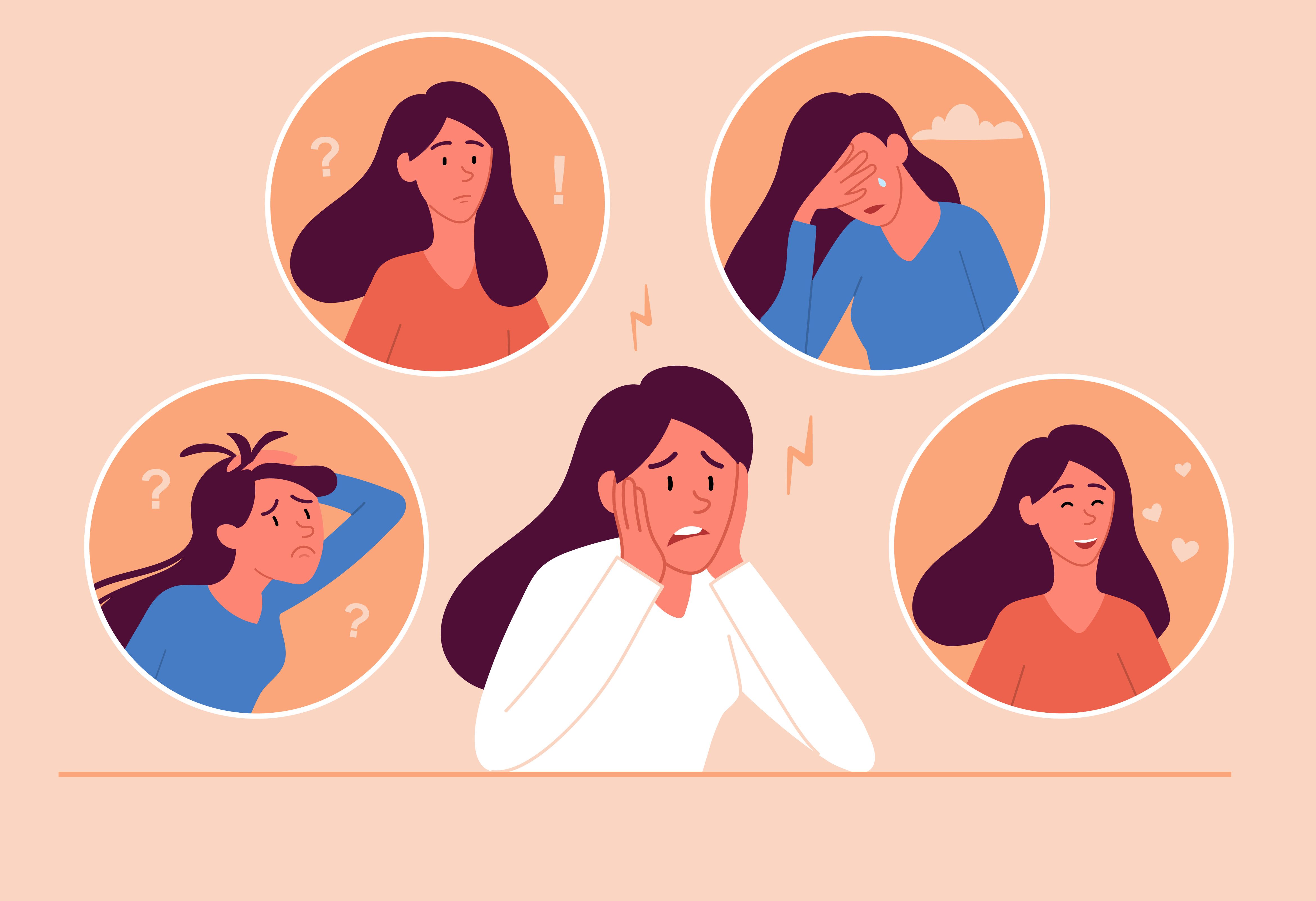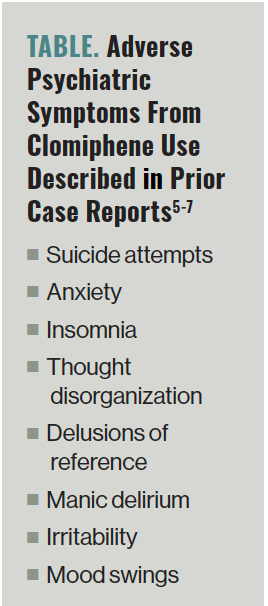News
Article
Psychiatric Times
Examining Risks of Reversible Clomiphene-Associated Manic Episodes to Patients
Author(s):
"Cumulatively, the findings of such reports have led to a concerted effort to encourage physicians to monitor patients for manic symptoms on initiation, reintroduction, and dose modulation of corticosteroid therapy."
Rudzhan_AdobeStock

ACADEMY OF CONSULTATION-LIAISON PSYCHIATRY
We recently managed a case of clomiphene (Clomid)–induced acute mania that was resolved following empiric treatment with olanzapine and discontinuation of clomiphene. Based on our experience with this case, we advise physicians to consider clomiphene-associated phenomena with acute psychiatric presentations shortly after use of clomiphene.
Discontinuing clomiphene, engaging in close serial clinical observation of mental status, empirically managing psychiatric symptoms, subsequently avoiding clomiphene, and following up clinically are indicated.
Case Report
The patient was a 37-year-old man with no prior medical history who presented with acute onset of psychomotor agitation, pressured speech, and psychosis. On day 1, the patient started using clomiphene as a supplement, which he had ordered from a website after a friend recommended it as a preworkout supplement that could “increase testosterone levels.”
The patient reported feeling “energetic” shortly after starting the drug; however, by day 3 of taking it, the patient felt that the sensation of increased energy was becoming “too much.” Notably, on that same date, the patient uncharacteristically drank 8 beers while attending a basketball game and consumed multiple shots of liquor later that evening.
Per collateral history from the patient’s wife, he took his last dose of clomiphene on day 7, at which time he appeared “elevated” and “hyperverbal.” On that date, he began to work out at 3:00 AM. His affect had become labile and he was not hungry, with decreased oral intake and loss of weight. Because this had never happened before, the patient’s wife made him an appointment with a community psychiatry clinic. On the evening of day 9, the patient was sent to the emergency department from the clinic and placed on a psychiatric commitment order.
He was initially seen in the emergency department on day 9 for acute onset of irritability, grandiosity, excess/nonsensical goal-directed behaviors, disorganized thinking, and decreased need for sleep. Family members reported that the patient had been having acute onset delusional thoughts and exhibiting signs of excess energy. The patient had never had similar symptoms before, and there was no family history of psychosis or mania.
Physical examination was notable for psychomotor agitation, flight of ideas, and tangential speech. Abnormal laboratory values included serum creatinine level of 1.19 mg/dL, aspartate level of 46 U/L, ketone level of 20 mg/dL, and thyroxine level of 1.73 ng/dL. To manage the patient’s acute agitation, the emergency physician administered 4 mg of intravenous (IV) midazolam and 5 mg of IV droperidol; after taking these medications, the patient improved and was subsequently discharged home on day 10 with a referral for outpatient psychiatric follow-up.
The patient’s wife stated that when she went to see her husband in the emergency department prior to discharge, he was still experiencing racing thoughts and had not fully returned to baseline.
Once the patient returned home, his wife noticed some improvement but noted that the patient was still reporting racing thoughts, whereupon he quickly experienced decompensation. He became perseverative and exhibited nonsensical behaviors, dropping to his knees while crying and calling his wife “Mommy.”
He was observed cleaning the house excessively and was overheard saying to himself, “You can’t go too fast,” which he claimed was to slow his thoughts down. He was noted to be “saying things in a loop,” exclaiming that “no one wants to connect” with pressured speech.
Furthermore, he was also observed pacing back and forth in the backyard, ripping a crucifix off the wall and breaking it, and referring to members of the family as religious figures. Throughout this episode, the patient reported feeling increasingly “ramped up.”
The patient’s relatives attempted to stay with the patient overnight to help calm him down and assist with sleep, but he did not sleep at all. His wife called her brother-in-law for help, whereupon the patient ran outside and began to pull grass out from their lawn. The patient’s wife, her brother-in-law, and additional family members called a nonemergency police line because they were concerned with the patient’s behavior.
Law enforcement came and transported the patient back to the emergency department on a second psychiatric commitment order. The patient stated that “it had to happen that way, because at that time I felt like no one could hurt me, not even getting shot by the police.”
On day 11, the patient was again seen in the emergency department for worsening symptoms, at which point he was given olanzapine, lorazepam, droperidol 5 mg, and midazolam 6 mg and was kept on the psychiatric observation unit attached to the emergency department.
Upon psychiatric evaluation on day 12, the patient stated that he felt the best that he had felt in the past few days. He attributed this improvement to the fact that he was “finally able to get sleep.” He reported feeling “really anxious” because of the demands of running a small business in addition to caring for his 5 children.
The patient recounted the events prior to this hospitalization, stating that he remembered feeling agitated while he was restrained in the emergency department. He reported feeling that he “could not turn off” his brain during the time he had severe symptoms. He readily agreed to abstain from using supplements such as clomiphene, drinking excessively, and using any illicit substance in the future. He was given a nighttime dose of olanzapine 5 mg and kept under observation.
Upon reevaluation on day 13, the patient said he was feeling “well” overall, that he was greatly improved compared with prior days, and that he was close to his baseline. From mental status examination (MSE), the patient appeared of stated age with well-groomed black/gray hair and beard.
He was cooperative, provided appropriate eye contact, and was able to recall events that led to his hospitalization with accurate dates. He did not exhibit any psychomotor agitation or psychomotor retardation. His speech was fluent with normal rate and rhythm. When asked about his mood, the patient stated that he was “mentally feeling good.”
His affect was congruent and stable, and his thought process was now linear. He had no suicidal or homicidal ideation. He was able to recall some of his thoughts from when he was in the manic episode (eg, “I feared my wife was going to leave me” and “I did not want to cooperate because I did not understand that they had my best interest in mind”).
The patient now demonstrated good insight and judgment. After visiting with his wife in the psychiatry observation unit, the patient was discharged in stable condition, with manic episode resolved, on maintenance olanzapine 5 mg at bedtime with instructions to obtain psychiatric follow-up within 1 week.
Discussion
Clomiphene is a selective estrogen receptor (ER) modulator that is clinically used to stimulate ovulation; however, it has also been used for the management of central hypogonadism. Findings from studies have established that it exerts its effects by blocking ERβ and activates or partially blocks ERα.1 By ultimately acting as a partial estrogen agonist in the hypothalamus, clomiphene results in estrogenic negative feedback inhibition that increases gonadotropins and stimulates ovulation.
Clinical application of low-dose clomiphene citrate in studies has shown to improve the testosterone to estradiol ratio and stimulate the endogenous androgen pathway, thereby potentially benefiting male patients with hypogonadism by improving libido, sexual function, bone density, mood, and other factors.2,3 Nevertheless, these reports have also highlighted the drug’s undesirable and deleterious effects including gynecomastia, testicular atrophy, declined sperm count, and skin irritation.
Clomiphene has been associated with psychiatric adverse effects including psychosis,4 with prior case reports describing adverse psychiatric symptoms (Table5-7).
Table. Adverse Psychiatric Symptoms From Clomiphene Use Described in Prior Case Reports5-7

Among these reports, there was variability in whether the patients had known prior psychiatric histories.
On day 1, the patient from our case report began to take clomiphene 25 mg daily. Within several days of starting clomiphene, he experienced an acute onset of mania, leading to social/occupational dysfunction and ultimately 2 emergency department presentations.
His subjective description of symptoms and emergency presentation were signs of a manic episode, including sleep disturbance with decreased need for sleep, psychomotor agitation, excessive energy, pressured speech, paranoia, flight of ideas, grandiosity, racing thoughts, increased goal-directed activities, impulsivity, and delusions.
The patient also reported a single day of heavy alcohol consumption at that time. Alcohol was likely contributory to his presentation; however, the patient was not a regular user of alcohol or other substances. It is plausible that disinhibition attributable to clomiphene contributed to his out-of-character use of alcohol.
Additionally, clomiphene is hepatically metabolized, and the patient first reported onset of manic symptoms the day of his drinking event. This raises the possibility that his hepatic metabolism of clomiphene was affected by this extensive consumption of alcohol, because liver metabolism of alcohol is a process largely facilitated by zero-order kinetics,8 which may have contributed to symptom onset.
The patient discontinued clomiphene after 7 daily doses, which he had been taking prior to exercise. His initial emergency department presentation was 10 days after starting clomiphene and 3 days after his last dose. Notably, this was the patient’s first manic episode at the age of 37 years. He did not have a history of major depressive disorder, and there was no family history of bipolar disorder. The timeline of patient’s clomiphene initiation and emergence of manic symptoms appeared temporally correlated, and his timeline of clomiphene use and subsequent symptoms was confirmed by his wife.
This case illustrates that a manic episode can be induced by systemic medications. Several cases of corticosteroid-induced mania have been cited in the literature, including reports of patients who, despite never having experienced neuropsychiatric symptoms while using corticosteroids routinely, exhibited manic symptoms after dose increases.
Other cases have found that patients exhibit manic symptoms when reinitiating corticosteroid therapy. Cumulatively, the findings of such reports have led to a concerted effort to encourage physicians to monitor patients for manic symptoms on initiation, reintroduction, and dose modulation of corticosteroid therapy.9,10
The patient from our case report had discontinued the clomiphene by the time he was held for a brief 48-hour observation in the emergency department. Daily monitoring of MSE and administration of 2 nighttime doses of olanzapine 5 mg resulted in recovery of baseline mental status within 48 hours.
Physicians are reminded that clomiphene and similarly acting agents may carry a risk of inducing manic episodes. If an isolated manic episode can be attributed to medication and/or substance use, this does not support a diagnosis of bipolar disorder (hence the DSM-5-TR diagnosis of substance/medication-induced bipolar and related disorder).
Thorough work-up including complete blood count, comprehensive metabolic panel, neuroimaging, infectious disease work-up, urine studies, and thyroid levels should be ordered, and empirical management of manic symptoms with olanzapine (or similarly acting agents) may lead to symptom resolution.
Our case highlights the importance of discussing the potential effects of initiating OTC supplements with physicians prior to initiation, because OTC supplements are not regulated by the FDA and may contain variable concentrations of the medication despite being purportedly labeled as containing a specific dose.
Additionally, it is possible that the supplement our patient took contained other drugs that could have caused these symptoms because one can never be sure of the ingredients of supplements purchased on the internet.
The findings in this case report and the cited literature further highlight the need for more thorough research studies to be conducted with larger sample sizes to better understand the risk that clomiphene use presents to patients and whether the risk varies greatly depending on age, body mass index, lifestyle factors, interactions with illicit substances, and other contributory variables.
Dr Tongpalad is a resident in psychiatry. Mr Gaeta and Mr Martin are medical students. Dr Santos is a clinical pharmacist. Dr Bourgeois is vice chair of hospital psychiatry services. All authors are at the University of California, Davis Medical Center in Sacramento.
References
1. Trost LW, Khera M. Alternative treatment modalities for the hypogonadal patient. Curr Urol Rep. 2014;15(7):417.
2. Liao Y, Chang YK, Wang SM, Chang HC. Ceiling effect of clomiphene citrate on the testosterone to estradiol ratio in eugonadal infertile men. PLoS One. 2022;17(1):e0262924.
3. Shabsigh A, Kang Y, Shabsign R, et al. Clomiphene citrate effects on testosterone/estrogen ratio in male hypogonadism. J Sex Med. 2005;2(5):716-721.
4. Mbi Feh MK, Wadhwa R. Clomiphene. In: StatPearls. 2023; StatPearls Publishing. Updated June 27, 2022. Accessed May 15, 2023. https://www.ncbi.nlm.nih.gov/books/NBK559292/
5. Knight JC, Pandit AS, Rich AM, et al. Clomiphene-associated suicide behavior in a man treated for hypogonadism: case report and review of the literature. Psychosomatics. 2015;56(5):598-602.
6. Sinha P, Garg A. Could clomiphene kindle acute manic episode in a male patient? a case report. Gen Hosp Psychiatry. 2014;36(5).
7. Parikh AR, Liskow BI. Manic delirium associated with clomiphene-induced ovulation. Psychosomatics. 2007;48(1):65-66.
8. Cederbaum AI. Alcohol metabolism. Clin Liver Dis. 2012;16(4):667-685.
9. Jasani R, Deacon JW, Sertich A. Corticosteroid-induced mania after previous tolerance of higher doses. Cureus. 2021;13(9):e17719.
10. Kazi SE, Hoque S. Acute psychosis following corticosteroid administration. Cureus. 2021;13(9):e18093.







